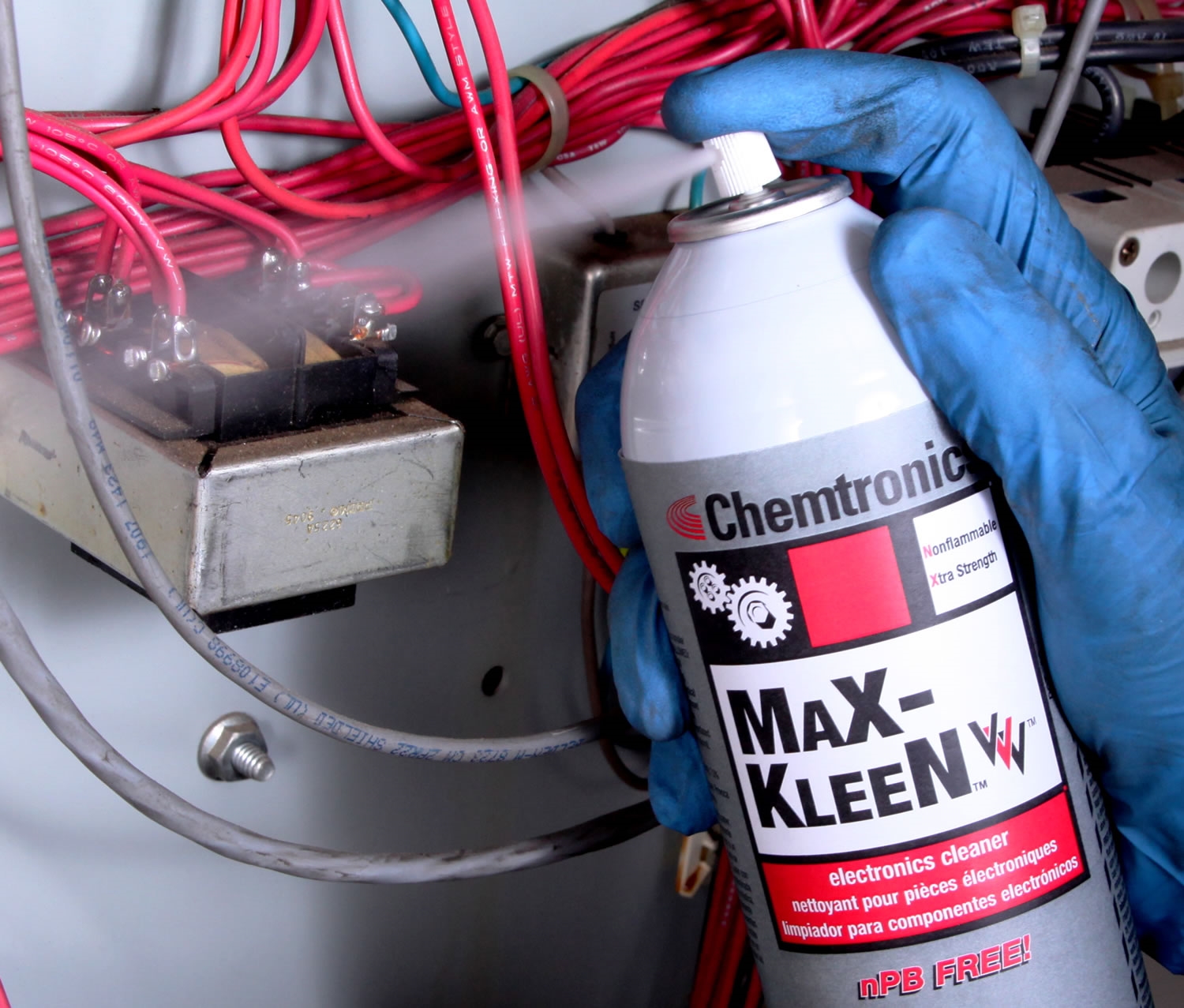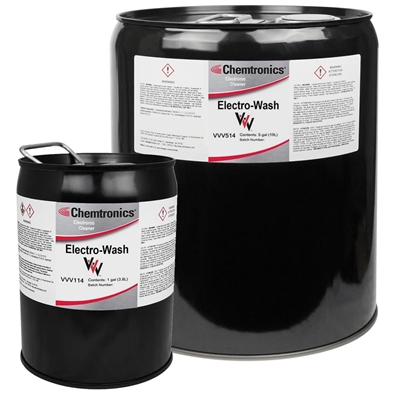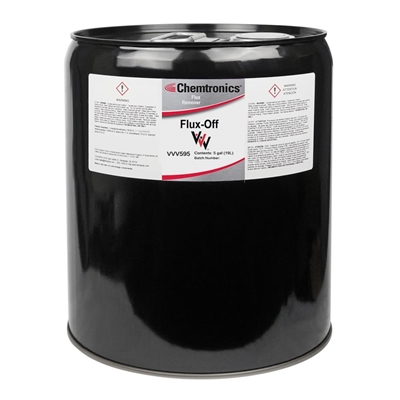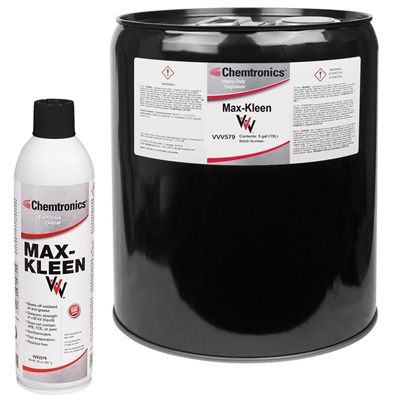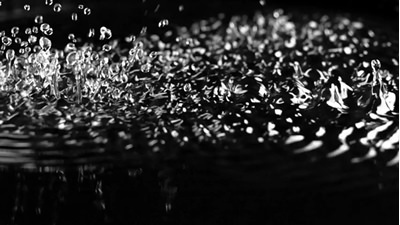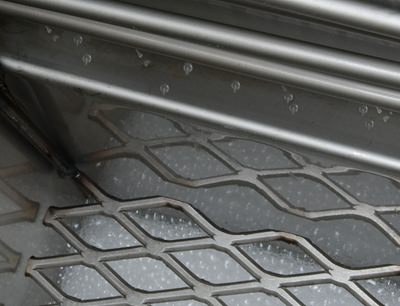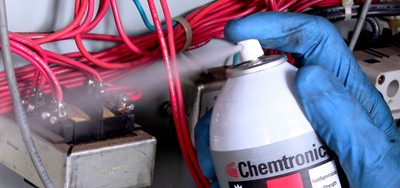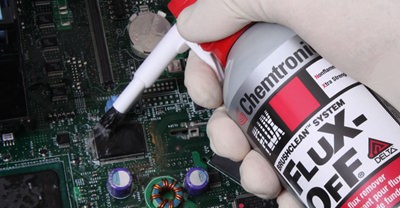Qualifying a replacement cleaning chemistry can be a daunting task, as performance parameters are considered along with safety and regulatory issues. Changes in the regulatory environment can force these changes, and unfortunately many substitute solvents do not match the performance and cost effectiveness of what they replace. Chemtronics performed an extensive battery of cleaning tests when developing Tri-V™ solvent cleaners. Test results are presented here to simplify and speed-up your qualification process.
There is currently a push to move away from common industrial solvents like n-propyl bromide (nPB), trichloroethylene (TCE), perchloroethylene (Perc) and methylene chloride (MeCl) because of toxicity concerns. Chemtronics has engineered the Tri-V™ high performance cleaning solvents to be safer replacements for these toxic products. Tri-V is formulated with trans 1,2-dichloroethylene (trans-DCE) and does not contain nPB, TCE, Perc, MeCl, or any other hazardous air pollutants (HAP).
Studies performed by the National Toxicology Program (NTP) and others have verified the low toxicity profile of trans-DCE (See white paper “Reducing Exposure to Toxic Cleaners with Replacement Solvents” for details. Available at www.chemtronics.com.), while this study indicates that its performance is superior.
Aerosol Cleaning Study
The aerosols included in the study included products from CRC and 3M, as well as Chemtronics Max Kleen™ Extreme, a nPB product. The method of evaluation was based on a military test standard, MIL-PRF-29608A (AS). Heavy duty Unilube All Purpose Greasewas applied on clean stainless steel coupons in triplicate. The weight of the clean coupon was recorded (W1). After the grease was applied, the coupon was weighed and recorded (W2). The soiled coupon was then sprayed for 3 seconds from a distance of 3 inches at a 45° angle. The coupon was allowed to dry completely before the weight was recorded again (W3). Cleaning efficiency was then determined by the calculation below with the average result recorded.
% Cleaning Efficiency (CE) = ((W2-W3) / ((W2-W1))*100
Solvent usage was assessed by weighing the aerosol can before and after the test, the difference being the solvent usage. Dividing by the spray time (3 seconds) provided the delivery rate (DRT).
The test data (fig 1) demonstrates that Tri-V outperformed the other solvents cleaners, both those containing nPB and Perc (fig 2) and trans-DCE based alternatives (fig 3).
In a side by side comparison, Tri-V also had greater efficiency, with less solvent required to clean the grease. The delivery rate of Tri-V was far less compared to the products whose outputs were higher, but did not have the same cleaning efficiency (fig 4). While many industrial cleaners have a satisfying blast, giving the perception of cleaning effectiveness, using Tri-V requires less material to achieve the cleaning performance demanded by technicians.
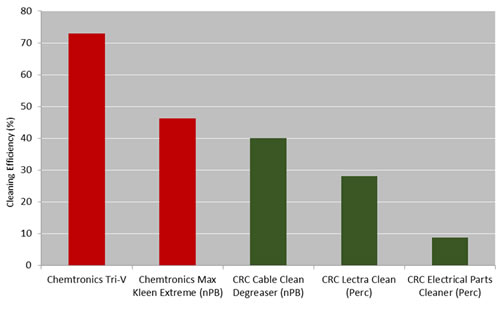
Figure 1: Cleaning efficiency and solvent usage data
|
PRODUCT |
BASE CHEMISTRY |
% CE |
DRT (g/sec) |
TOTAL SOLVENT USAGE (g) |
|
Chemtronics Tri-V™ |
Trans-DCE |
73.0 |
5.4 |
16.2 |
|
Max Kleen Extreme |
nPB |
46.3 |
6.4 |
19.2 |
|
CRC Cable Clean Degreaser |
nPB |
40.0 |
8.0 |
24.0 |
|
CRC Electronic Component Cleaner |
Trans-DCE |
38.7 |
5.3 |
15.9 |
|
3M Novec Electronics Cleaner |
Trans-DCE |
35.1 |
7.0 |
20.9 |
|
CRC Lectra Clean |
Perc |
28.1 |
11.5 |
34.4 |
|
CRC Electrical Parts Cleaner |
Perc |
8.7 |
16.7 |
50.1 |
Figure 2: Cleaning efficiency comparison vs. nPB and Perc
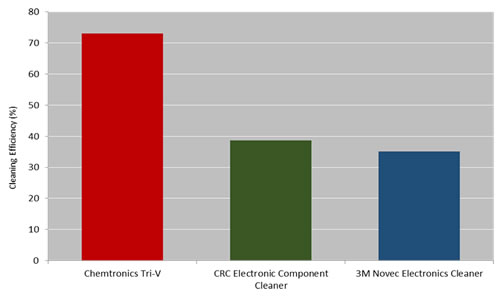
Figure 3: Cleaning efficiency comparison vs. other Trans-DCE blends

Figure 4: Cleaning efficiency and solvent usage comparison
Vapor Degreasing Cleaning Study
Vapor degreasing involves specialized cleaning equipment that is capable of cleaning or rinsing in the vapor-phase of a boiling solvent. The cleaning method is commonly used in the most critical applications, like aerospace and medical electronics, because the solvent is always freshly distilled and free of contamination. The distillation process is constant, as solvent boils, vaporizes, and is condensed again for hundreds of cycles a day. This process requires specialized solvents that maintain their properties (nonflammability being particularly important) through days and weeks of cycling, and stabilized to prevent corrosiveness as moisture is absorbed from ambient air.
Since Chemtronics Tri-V high performance solvents are engineered for stability in the vapor degreasing process, the cleaning efficiency on a wide variety of soils were evaluated. Soils tested were Alox 165L (corrosion inhibitor), Royco 782 (hydraulic fluid), silicone fluid (TBF9350), 80W-140 motor oil, Unilube All Purpose Grease, CRC Food Grade Chain Lube, and two different fluxes. The soils were applied to stainless steel coupons. The fluxed coupons were sent through a reflow oven at a profile that peaked at 446°F (230°C) to fully activate. To clean the coupons, they were exposed for three minutes in the hot vapor phase using a Branson B250R vapor degreaser. No further agitation was used, and the coupons were not wiped after the cleaning process. The percent cleaning efficiency was then calculated and recorded as mentioned previously (fig 5). Results demonstrate that Tri-V™ is effective on a wide range of soils in the vapor degreasing process.
Figure 5: Tri-V cleaning efficiency in vapor degreasing process
|
SOIL |
Ave. Cleaning Efficiency |
|
SOIL |
Ave. Cleaning Efficiency |
|
Alox 165L |
100.0 |
|
Unilube |
65.4 |
|
Royco 782 |
100.0 |
|
Chain Lube |
99.9 |
|
Silicone Fluid |
99.6 |
|
Kester 186 |
100.0 |
|
APG 80W-140 |
100.0 |
|
AIM NC277 |
97.5 |
Flux Removal from PCB Study
Activated flux residues on a printed circuit board poses additional challenges beyond standard degreasing, because of the tenaciousness of the soil and the extreme temperatures in the soldering processes. Because of this, we performed an additional study with solder paste and liquid fluxes to duplicate the soldering process as closely as possible.
The pastes were reflowed on the test PCB with components with a Novastar DDM reflow oven according to the paste profiles. The liquid fluxes were applied only to the test vehicle pads and put into a Plato SP-600T solder pot, filled with Kester K-100 solder at 550°F (288°C), to simulate wave conditions and activate the flux. After soldering, the PCBs sat for 4-hours to approximate a typical work flow.
To clean, the soiled and baked PCB were suspended in the vapor-degreaser (Branson B250R) vapor zone for 5 mins, then submerged into the boil sump for 3 mins. Performance evaluation was done by a subjective review of cleaned PCBs magnified at 120X (see fig 7-10 for examples). Each sample was ranked according to visual cleanliness (fig 6).
Figure 6: PCB cleanliness testing of Tri-V Flux Remover in vapor degreaser
| 1 = complete removal | 3 = partial removal |
| 2 = slight flux residue/white residue | 4 = non-removal |
|
Paste/flux ID |
Cleanliness Ranking |
|
Paste/flux ID |
Cleanliness Ranking |
|
AIM M8 |
1 |
|
Indium 5.1 |
1 |
|
AIM NC259 |
2 |
|
Indium 5.1AT |
2 |
|
AIM 257-2 |
3 |
|
Indium 5.8LS |
2 |
|
AIM NC258 |
2 |
|
Indium 8.9 |
2 |
|
Aim NC512 |
2 |
|
Indium 8.9E |
3 |
|
Alpha OM-338 |
2 |
|
Indium 8.9HF1 |
2 |
|
Alpha OM-338PT |
3 |
|
Indium 8.9HFA |
3 |
|
Alpha OM-338T |
3 |
|
Indium 9.0 |
3 |
|
Alpha OM-340 |
3 |
|
Indium 10.1 |
3 |
|
Alpha OM-5000 |
2 |
|
Indium 10.5HF |
2 |
|
Alpha OM-5100 |
3 |
|
Kester 186 liq flux |
1 |
|
Alpha R-100 liq flux |
1 |
|
Kester EP256 |
1 |
|
Alpha 615-25 liq flux |
1 |
|
Kester 256HA |
2 |
|
Indium NC-SMQ92H |
2 |
|
Kester NP 505HR |
1 |
|
Indium NC-SMQ92J |
2 |
|
Loctite HF212 |
2 |
|
Indium NC-SMQ230 |
2 |
|
Loctite MP218 |
3 |
|
Indium RMA-SMQ51AC |
1 |
|
|
|
 |
 |
| Fig. 7: Indium SMQ 51AC, MLF40 preclean | Fig. 8: Indium SMQ 51 AC, MLF40 post clean |
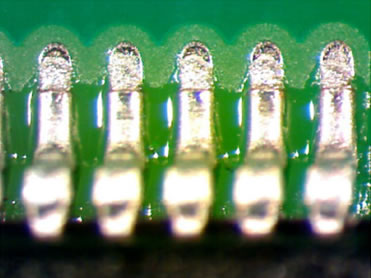 |
 |
| Fig. 9: Kester NP505 HR, QFP80 preclean | Fig. 10: Kester NP505 HR, QFP80 post clean |
Chemtronics has engineered the Tri-V high performance cleaning solvents to be a safer replacement for n-propyl bromide and other toxic solvents, and better cleaning performance than 3M Novec solvents and others. These studies demonstrate that regardless of the cleaning process, facilities can change to Tri-V without negatively impacting their operating cost, efficiency, and product reliability.

